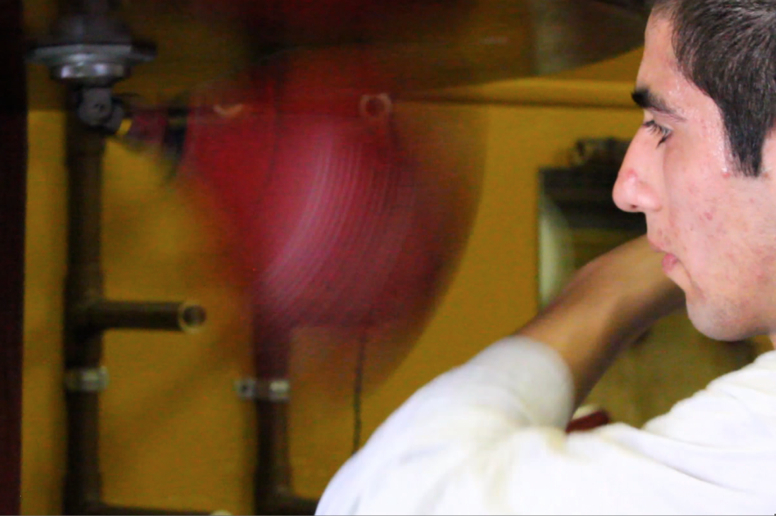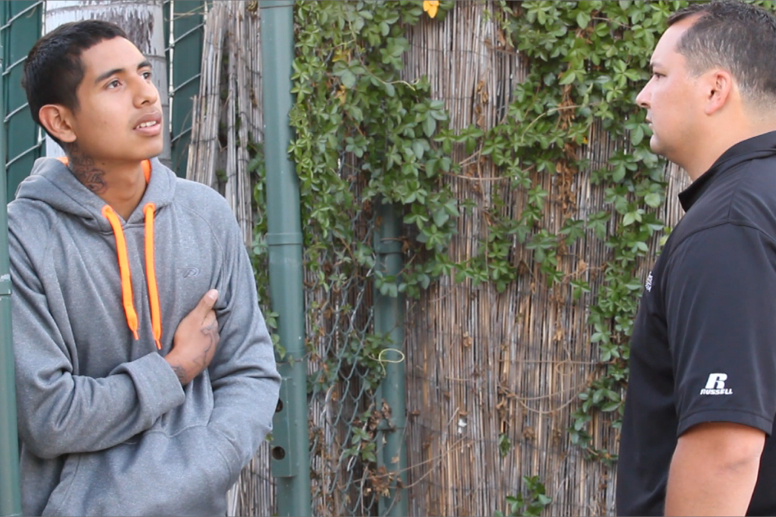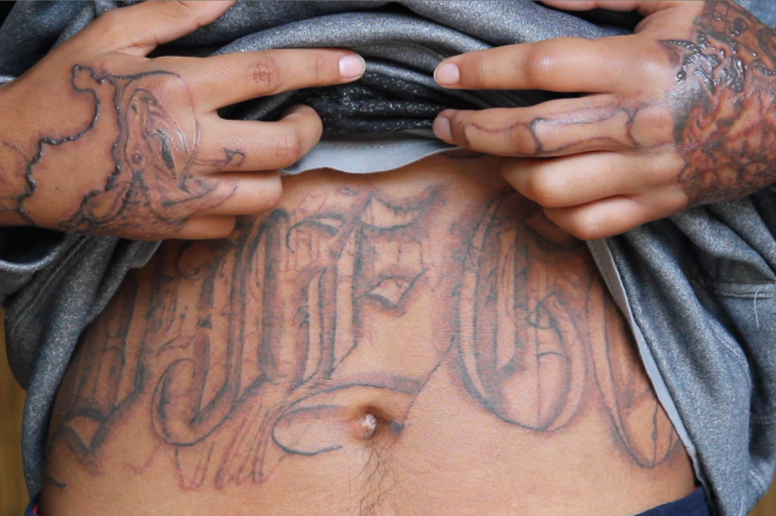In the past, parents might not learn their children are documented gang members until they’re summoned to court for the child’s arraignment. Now, under a new state law, parents will discover police believe their children are gang members in a letter instead of in court. Speak City Heights reporter Megan Burks says the letters are a win for transparency, but so far, not much else. | Video Credit: Katie Schoolov, KPBS
By Megan Burks
“A Letter Parents Don’t Want to Get From the Cops,” aired on KPBS Radio May 7, 2014
[audio:http://speakcityheights.org/wp-content/uploads/2014/04/20140507-MEB-PARENTAL.mp3]
A new state law went into effect this year requiring law enforcement agencies to notify parents when their children have been entered into a statewide gang database. The law came after civil liberties groups and residents in communities with heavy gang activity – and policing – called for more transparency.
The CalGang system is notoriously impervious to records requests. It’s possible that an individual won’t find out they’re even in the database until he or she is in court facing a stiffer sentence for a crime because records indicate they’re gang-involved.
Now parents will learn police believe their children are gang members in a letter instead of an arraignment. But there’s still a dilemma the new law doesn’t solve: what to do once the letter arrives.
San Diego gang Lt. Mark Bennett said his department has sent 10 of the letters this year. The response? Crickets.
“The parents are already usually detached from their kids or sometimes the parents are gang members,” Bennett said. “So we don’t get a lot of positive response.”
Bennett said officers have typically observed the individuals they document associating with gang members and wearing gang insignia a dozen or so times – well above the three write-ups they need by law to add them to CalGangs.
The notification letters offer a direct line to Bennett and his colleagues and encourage parents to appeal the decision. So far, no one has. When parents did respond, Bennett said, the communication fell off because of fear.
“Just a month ago we contacted a parent. The parent knew the kid was in the gang culture and seemed real interested in the gang intervention program that we have,” Bennett said. “Then on some follow-up phone calls they expressed that they were afraid their kid would actually label them as a snitch.”
Kahalifa King said the police and the public shouldn’t be quick to judge parents for their silence. He’s a marriage and family therapist with Harmonious Solutions, a mental health service provider for San Diego’s minority communities, and a former gang mediator for the Legal Aid Society.
King said even parents who were gang members themselves often want better outcomes for their kids. And he said he doesn’t believe the anti-snitching culture documented in Baltimore, Chicago and, more recently, Chattanooga, exists in San Diego to the degree that parents wouldn’t seek help.
“I’d say that’s a very small percentage, because in our community, we are not afraid of our kids in the way that other communities outside of our culture want to sensationalize,” King said. “I’m not saying it doesn’t happen, but most of us don’t stand for that.”
Instead, King said it’s a matter of trust, an issue Bennett brought up, too. The relationship between families impacted by gangs and the San Diego Police Department “is not a very good one,” King said.
“The letter may seem like an indictment on the family and, from a cultural standpoint, there’s always been an historical indictment on these families anyway,” he said.
King said a better approach might be to recruit social service practitioners who are a part of the community to accompany plain-clothes officers to relay the message in person.
“Oftentimes the community will respond to its own rather than someone outside of the community,” King said.
 The San Diego Police Department’s gang unit runs a diversionary program out of JSK Boxing gym in Pacific Beach. The gang intervention officer drives youth from all over the city to the gym to teach them discipline and responsibility. | Photo Credit: Katie Schoolov, KPBS
The San Diego Police Department’s gang unit runs a diversionary program out of JSK Boxing gym in Pacific Beach. The gang intervention officer drives youth from all over the city to the gym to teach them discipline and responsibility. | Photo Credit: Katie Schoolov, KPBS
It’s a strategy San Diego gang officer John Carroll is implementing earlier in the documentation process – with mixed results. Six months ago, he started calling parents when he would first question a minor for looking or behaving like he or she might be in a gang. But Carrol is hitting the same wall of silence – arguably, at a time when parents should feel more confident stepping in.
“I’ll get good responses at first, but then the parents will never follow up. I’ve called parents two or three times to no avail,” Carroll said. “I’ve said I’d go to their house, I would go to the school to meet with the kid. A lot of times I find out the moms don’t want … the moms don’t want the sons to know that they’re actually even talking to the police.”
From the outside, it looks like half of Carroll’s job is running a carpool. He’s the department’s only gang intervention officer, which means he’s stepped into the lives of about 30 young men and women to keep them from getting caught up in San Diego’s gang culture, or to help them get out of it.
There’s the traditional carpool function; some of the guys catch a ride with him to school. But he also drives a handful to regular tattoo removal appointments and, three days a week, shuttles about a dozen to and from JSK Boxing gym in Pacific Beach.
There, Carroll and JSK trainers teach them how to fight in a ring, imparting the values of discipline and responsibility so they’ll learn to fight for their futures, too.
But the will to fight, Carroll said, never really comes from adults – or a letter.
“The No. 1 thing is, we cannot change their mind,” Carroll said. “They have to want to do it. I as a person, I as a police officer, I cannot make a kid change their mind.”
That’s the case for Christian Felipe, 17. The Crawford High School student said he hasn’t been involved in gangs but has spent some time in jail. He didn’t say why.
 Christian Felipe talks with former gang intervention officer Ryan Welch, who started the police department’s boxing program for youth at-risk of joining gangs after asking those he encountered in the community to join his morning workouts. “I created a monster,” Welch said of the program, which continues to grow despite its tight, donations-based budget. It costs about $1,000 a month to rent out the gym. | Photo Credit: Katie Schoolov, KPBS
Christian Felipe talks with former gang intervention officer Ryan Welch, who started the police department’s boxing program for youth at-risk of joining gangs after asking those he encountered in the community to join his morning workouts. “I created a monster,” Welch said of the program, which continues to grow despite its tight, donations-based budget. It costs about $1,000 a month to rent out the gym. | Photo Credit: Katie Schoolov, KPBS
On a recent Tuesday he sat out during training because he was swollen and sore from a tattoo removal session. His legs, arms, torso and neck are covered in now-blistered tattoos.
A friend’s uncle used a homemade tattoo gun to give him his first tattoo at age 14. Felipe then engineered his own gun and started practicing on his arm, eventually inking an entire sleeve and moving on to his stomach.
Felipe said he didn’t change course until he realized he wants to join the Army. He’s taking night classes to graduate on time and, despite enduring significant pain, has declined offers to go easy on him with the tattoo removal laser. He doesn’t want any more delays.
“I want to serve my country,” Felipe said.
 Christian Felipe tattooed his own stomach with a tattoo gun he made at age 14. | Photo Credit: Katie Schoolov, KPBS
Christian Felipe tattooed his own stomach with a tattoo gun he made at age 14. | Photo Credit: Katie Schoolov, KPBS
About 50 youth complete the boxing program annually. Many walk away with champion belts and jobs to tuck under them. Half, like Felipe, are there to right their course. The other half is considered at-risk and is there to keep on track.
But overall, getting young men and women to where Felipe is before they go to jail and before a gang documentation letter is drafted is something King, other service providers and the police say San Diego hasn’t fully figured out.
Bennett said the number of gang members in the city remains steady year after year at around 4,100. Between 50 and 100 leave the lifestyle each month but are quickly replaced by new recruits, he said.
And while he’s only just begun to implement the new parental notification program, Bennett said it’s not making much of an impact outside of increasing transparency.
“If I had even half a success story, I’d share it,” Bennett said. “But I don’t.”
